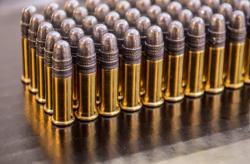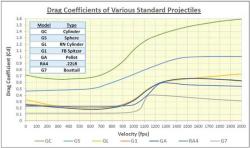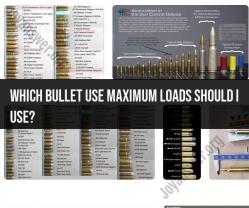Which bullet use maximum loads should I use?
Determining the maximum loads for your ammunition, including the type of bullet and powder charge, is a critical safety consideration for reloaders and handloaders. Using excessive loads can lead to dangerous overpressure situations, firearm damage, and potentially severe injury. Here's how to choose maximum loads safely:
Consult Reliable Data Sources:
- Always start with published load data from reputable sources. These sources include ammunition and powder manufacturers, as well as reloading manuals. The most widely recognized and trusted reloading manuals are published by companies like Hornady, Sierra, Speer, Lyman, and others. These manuals provide detailed load data for various bullet types, powders, and cartridges.
Select the Bullet Type and Weight:
- Choose the specific bullet type and weight that you intend to use in your reloading project. Load data can vary significantly based on the bullet's construction and weight, so be sure to match the data to your components.
Choose the Correct Powder:
- The load data will specify the appropriate powder or powders to use with your chosen bullet and cartridge. Make sure you have the exact powder specified in the data or an appropriate substitute if necessary.
Start with Starting Loads:
- Most load data will provide starting loads and maximum loads for each combination of bullet, powder, and cartridge. Always begin with the starting loads, especially if you are new to reloading or working with a new component combination.
Work Up Gradually:
- When starting with the minimum or starting load, gradually increase the powder charge in small increments while monitoring for pressure signs. Pressure signs can include flattened primers, hard extraction, case bulging, and other visual or tactile indicators. Cease load development if you observe any pressure signs.
Chronograph Velocity:
- Use a chronograph to measure the velocity of your handloads. This helps ensure that your loads are within safe and acceptable velocity ranges.
Reference Load Data:
- Continuously refer to the load data throughout the development process, making sure you are within the specified maximum load limits.
Maintain Consistency:
- Keep your reloading process consistent and precise. Use a reliable powder scale, consistent brass cases, primers, and maintain a clean and organized reloading environment.
Document Your Loads:
- Keep detailed records of your reloading process, including the components used, powder charges, primer types, and any pressure signs observed. This documentation can be valuable for future reference and load development.
Exercise Caution:
- Safety should always be the top priority in reloading. If you have any doubts or concerns about your loads, err on the side of caution and do not proceed with higher charges.
Remember that the goal of handloading ammunition is not to achieve the maximum possible velocity but to develop safe and accurate loads for your specific firearm. Following published load data and exercising caution throughout the process is crucial to ensure your safety and the reliability of your ammunition. Always adhere to firearm safety rules and guidelines when working with ammunition.
Navigating Maximum Loads: Guidelines for Safe Ammunition Reloading
Maximum loads are the highest recommended powder charges for a particular cartridge and bullet combination. They are published by reloading manuals and websites, and are based on extensive testing. However, it is important to note that maximum loads are not always safe, and should only be used by experienced reloaders.
There are a number of factors that can affect the safety of a maximum load, including:
- The quality of the components: Poor quality components can lead to overpressure and dangerous conditions.
- The condition of the firearm: A firearm that is not in good condition may not be able to handle the pressure of a maximum load.
- The environmental conditions: Extreme heat or cold can affect the pressure of a maximum load.
It is important to start well below the maximum load when reloading a new cartridge and bullet combination. Once you have found a load that is accurate and reliable, you can gradually increase the powder charge until you reach the maximum load. However, it is important to stop increasing the powder charge if you see any signs of overpressure, such as:
- Sticky bolt or extractor: This can be caused by the case expanding too much under pressure.
- Flattened or dented primer: This can be caused by the primer being pushed back into the case under pressure.
- Sooty cases: This can be caused by the powder not burning completely under pressure.
If you see any signs of overpressure, stop using the load and reduce the powder charge.
Reloading with Caution: Understanding Maximum Loads for Bullets
It is important to understand that maximum loads are not always safe. Maximum loads are based on extensive testing, but there is always some variation in the components and environmental conditions. This means that a maximum load may be safe in one firearm, but unsafe in another.
It is also important to note that maximum loads are not always necessary. In most cases, you can find a load that is accurate and reliable below the maximum load. This is especially important if you are new to reloading or if you are shooting a firearm that is not in good condition.
Reloader's Dilemma: Choosing Maximum Loads for Safe and Effective Shooting
The reloader's dilemma is choosing a load that is both safe and effective. Maximum loads are often the most effective loads, but they may not be safe. It is important to weigh the risks and benefits of using a maximum load before deciding whether to use it.
If you are unsure whether a maximum load is safe, it is best to err on the side of caution and use a lower powder charge. You can always increase the powder charge later if you need to.
Here are some additional tips for navigating maximum loads safely:
- Always start well below the maximum load when reloading a new cartridge and bullet combination.
- Increase the powder charge gradually and stop if you see any signs of overpressure.
- Use high quality components and keep your firearm in good condition.
- Be aware of the environmental conditions and avoid shooting in extreme heat or cold.
- If you are unsure whether a maximum load is safe, err on the side of caution and use a lower powder charge.
By following these tips, you can navigate maximum loads safely and effectively.













